

Digestate - Wikipedia, the free encyclopedia - (Build 2010040106. Digestate is the material remaining after the anaerobic digestion of a biodegradable feedstock.
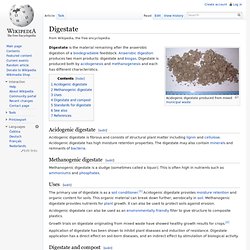
Anaerobic digestion produces two main products: digestate and biogas. Digestate is produced both by acidogenesis and methanogenesis and each has different characteristics. Acidogenic digestate[edit] Acidogenic digestate is fibrous and consists of structural plant matter including lignin and cellulose. Acidogenic digestate has high moisture retention properties. Biomass - Wikipedia, the free encyclopedia - (Build 201004010646. Sugarcane plantation in Brazil (State of São Paulo).
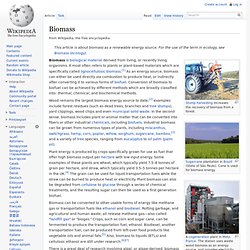
Cane is used for biomass energy. A cogeneration plant in Metz, France. The station uses waste wood biomass as an energy source, and provides electricity and heat for 30,000 dwellings. Biomass is biological material derived from living, or recently living organisms. It most often refers to plants or plant-based materials which are specifically called lignocellulosic biomass.[1] As an energy source, biomass can either be used directly via combustion to produce heat, or indirectly after converting it to various forms of biofuel. Wood remains the largest biomass energy source to date;[2] examples include forest residues (such as dead trees, branches and tree stumps), yard clippings, wood chips and even municipal solid waste. Plant energy is produced by crops specifically grown for use as fuel that offer high biomass output per hectare with low input energy. The biomass used for electricity generation varies by region.
Miscanthus - Wikipedia, the free encyclopedia - (Build 201004010. Miscanthus is a genus of about 15 species of perennial grasses native to subtropical and tropical regions of Africa and southern Asia, with one species (M. sinensis) extending north into temperate eastern Asia.
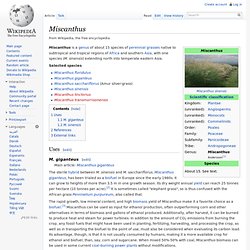
Selected species Uses[edit] M. giganteus[edit] Panicum virgatum - Wikipedia, the free encyclopedia - (Build 201. Panicum virgatum, commonly known as switchgrass, is a perennial warm season bunchgrass native to North America, where it occurs naturally from 55°N latitude in Canada southwards into the United States and Mexico.
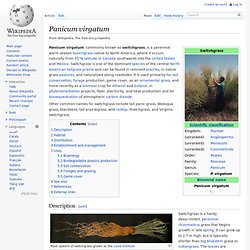
Hemp - Wikipedia, the free encyclopedia - (Build 20100401064631) Other variants of the herb Cannabis sativa are widely used as a drug, commonly known as marijuana.
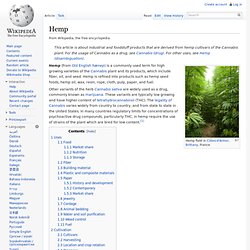
These variants are typically low growing and have higher content of tetrahydrocannabinol (THC). The legality of Cannabis varies widely from country to country, and from state to state in the United States. In many countries regulatory limits for concentrations of psychoactive drug compounds, particularly THC, in hemp require the use of strains of the plant which are bred for low content.[1] Uses[edit] Hemp grown for milk animal fodder. Populus - Wikipedia, the free encyclopedia - (Build 201004010646. Populus is a genus of 25–35 species of deciduous flowering plants in the family Salicaceae, native to most of the Northern Hemisphere.

English names variously applied to different species include poplar /ˈpɒp.lər/, aspen, and cottonwood. Description[edit] The genus has a large genetic diversity, and can grow from anywhere between 15–50 m (49–164 ft) tall, with trunks of up to 2.5 m (8 ft 2 in) diameter. Male catkins of Populus × canadensis Ecology[edit] Poplars of the cottonwood section are often wetlands or riparian trees. Sorghum - Wikipedia, the free encyclopedia - (Build 201004010646. Sorghum is a genus of grasses with about 30 species, one of which is raised for grain and many of which are used as fodder plants, either cultivated or as part of pasture.
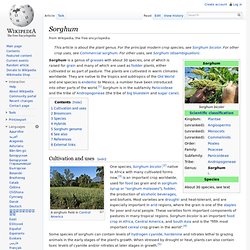
The plants are cultivated in warm climates worldwide. They are native to the tropics and subtropics of the Old World and one species is endemic to Mexico, a number have been introduced into other parts of the world.[1] Sorghum is in the subfamily Panicoideae and the tribe of Andropogoneae (the tribe of big bluestem and sugar cane). Sugarcane - Wikipedia, the free encyclopedia - (Build 2010040106. Cut sugarcane Sugarcane, or sugar cane, is any of several species of tall perennial true grasses of the genus Saccharum, tribe Andropogoneae, native to the warm temperate to tropical regions of South Asia, and used for sugar production.

Sugarcane belongs to the grass family (Poaceae), an economically important seed plant family that includes maize, wheat, rice, and sorghum and many forage crops. The main product of sugarcane is sucrose, which accumulates in the stalk internodes. Sucrose, extracted and purified in specialized mill factories, is used as raw material in human food industries or is fermented to produce ethanol. Ethanol is produced on a large scale by the Brazilian sugarcane industry. Sugarcane is the world's largest crop by production quantity.[1] In 2012, FAO estimates it was cultivated on about 26.0 million hectares, in more than 90 countries, with a worldwide harvest of 1.83 billion tons. The world demand for sugar is the primary driver of sugarcane agriculture. Willow - Wikipedia, the free encyclopedia - (Build 2010040106463.
Willows, sallows, and osiers form the genus Salix, around 400 species[2] of deciduous trees and shrubs, found primarily on moist soils in cold and temperate regions of the Northern Hemisphere.

Most species are known as willow, but some narrow-leaved shrub species are called osier, and some broader-leaved species are referred to as sallow (from Old English sealh, related to the Latin word salix, willow). Some willows (particularly arctic and alpine species) are low-growing or creeping shrubs; for example, the dwarf willow (Salix herbacea) rarely exceeds 6 cm (2 in) in height, though it spreads widely across the ground. Maize - Wikipedia, the free encyclopedia - (Build 20100401064631. Maize (/ˈmeɪz/ MAYZ; Zea mays subsp. mays, from Spanish: maíz after Taíno mahiz), known in some English-speaking countries as corn, is a large grain plant domesticated by indigenous peoples in Mesoamerica in prehistoric times.

The leafy stalk produces ears which contain the grain, which are seeds called kernels. Maize kernels are often used in cooking as a starch. History A maize heap at the harvest site, India Most historians believe corn was domesticated in the Tehuacan Valley of Mexico.[1] The Olmec and Mayans cultivated it in numerous varieties throughout Mesoamerica, cooked, ground or processed through nixtamalization. Maize is the most widely grown grain crop throughout the Americas,[3] with 332 million metric tons grown annually in the United States alone. Words for maize Many small male flowers make up the male inflorescence, called the tassel. Energy crop - Wikipedia, the free encyclopedia - (Build 20100401.
An energy crop is a plant grown as a low-cost and low-maintenance harvest used to make biofuels, such as bioethanol, or combusted for its energy content to generate electricity or heat. Energy crops are generally categorized as woody or herbaceous plants; many of the latter are grasses (Graminaceae). Commercial energy crops are typically densely planted, high-yielding crop species where the energy crops will be burnt to generate power. Eucalyptus - Wikipedia, the free encyclopedia - (Build 201004010. Some eucalyptus species have attracted attention from horticulturists, global development researchers and environmentalists because of desirable traits such as being fast-growing sources of wood, producing oil that can be used for cleaning and as a natural insecticide, or an ability to be used to drain swamps and thereby reduce the risk of malaria.
Outside their natural ranges, eucalypts are both lauded for their beneficial economic impact on poor populations[5][6]:22 and criticised for being "water-guzzling" aliens,[7] leading to controversy over their total impact.[8] Description[edit] Size and habit[edit] A mature eucalyptus may take the form of a low shrub or a very large tree. There are three main habits and four size categories that species can be divided into. The term marlock has been variously used; in Forest Trees of Australia it is defined as a small tree without lignotubers but with a shorter, lower-branching trunk than a mallet.
Tree sizes follow the convention of: Oil palm - Wikipedia, the free encyclopedia - (Build 20100401064. Human use of oil palms may date as far back as 5,000 years in West Africa; in the late 1800s, archaeologists discovered palm oil in a tomb at Abydos dating back to 3,000 BCE.[3] It is thought that Arab traders brought the oil palm to Egypt.[4] Description[edit] Mature palms are single-stemmed and grow to 20 m tall. Biomass Program: ABC's of Biofuels - (Build 20100401064631)